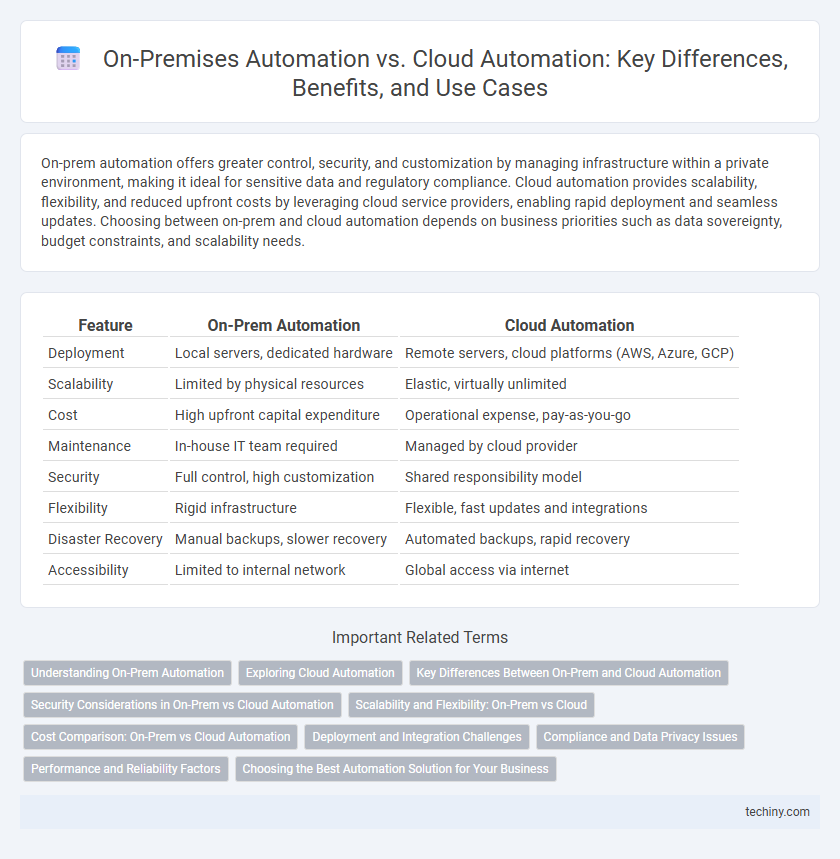On-prem automation offers greater control, security, and customization by managing infrastructure within a private environment, making it ideal for sensitive data and regulatory compliance. Cloud automation provides scalability, flexibility, and reduced upfront costs by leveraging cloud service providers, enabling rapid deployment and seamless updates. Choosing between on-prem and cloud automation depends on business priorities such as data sovereignty, budget constraints, and scalability needs.
Table of Comparison
| Feature | On-Prem Automation | Cloud Automation |
|---|---|---|
| Deployment | Local servers, dedicated hardware | Remote servers, cloud platforms (AWS, Azure, GCP) |
| Scalability | Limited by physical resources | Elastic, virtually unlimited |
| Cost | High upfront capital expenditure | Operational expense, pay-as-you-go |
| Maintenance | In-house IT team required | Managed by cloud provider |
| Security | Full control, high customization | Shared responsibility model |
| Flexibility | Rigid infrastructure | Flexible, fast updates and integrations |
| Disaster Recovery | Manual backups, slower recovery | Automated backups, rapid recovery |
| Accessibility | Limited to internal network | Global access via internet |
Understanding On-Prem Automation
On-prem automation involves deploying and managing automation tools and workflows directly within an organization's local data center, providing greater control over security, compliance, and custom configurations. This approach enables organizations to leverage existing infrastructure investments and ensures low-latency access to critical systems. Understanding on-prem automation is essential for businesses prioritizing data sovereignty and requiring tailored automation solutions that align with internal policies.
Exploring Cloud Automation
Cloud automation leverages scalable infrastructure and advanced APIs to streamline deployment, monitoring, and management of applications with minimal manual intervention. It enables real-time resource provisioning, automated scaling, and continuous integration/continuous deployment (CI/CD) pipelines, reducing operational costs and enhancing agility. Enterprises adopting cloud automation benefit from improved disaster recovery, consistent environment replication, and seamless integration with AI-driven analytics for optimized performance.
Key Differences Between On-Prem and Cloud Automation
On-prem automation involves deploying and managing automation tools within a company's physical infrastructure, offering greater control over data security and compliance but requiring significant upfront investment and maintenance. Cloud automation leverages scalable, remote resources that reduce hardware costs and enable rapid deployment with enhanced flexibility and accessibility from anywhere. The key differences lie in cost structure, scalability, control, and maintenance responsibilities, with on-prem demanding more internal IT management and cloud automation benefiting from provider-managed updates and infrastructure.
Security Considerations in On-Prem vs Cloud Automation
On-prem automation offers enhanced control over sensitive data and compliance by keeping all processes within the organization's physical infrastructure, reducing exposure to external threats. Cloud automation provides robust security measures through provider-managed encryption, advanced threat detection, and continuous monitoring but introduces risks linked to multi-tenant environments and third-party access. Evaluating security policies, access management protocols, and data residency requirements is essential when choosing between on-prem and cloud automation solutions.
Scalability and Flexibility: On-Prem vs Cloud
On-prem automation offers limited scalability due to hardware constraints and requires manual upgrades to accommodate increased workloads, impacting overall flexibility. Cloud automation provides dynamic scalability through elastic resource allocation, enabling organizations to rapidly adjust to changing demands without significant infrastructure investments. This inherent flexibility allows cloud automation to support diverse and evolving business processes more efficiently than on-prem solutions.
Cost Comparison: On-Prem vs Cloud Automation
On-premises automation requires significant upfront capital investment in hardware, software, and maintenance, leading to higher initial costs compared to cloud automation. Cloud automation offers a pay-as-you-go pricing model, reducing operational expenses through scalable resources and minimal infrastructure management. Over time, cloud automation typically results in lower total cost of ownership (TCO) due to reduced IT staffing needs and the ability to quickly adapt to changing workloads without additional capital expenditure.
Deployment and Integration Challenges
On-premises automation offers direct control over deployment environments but often faces complex integration challenges with legacy systems and limited scalability. Cloud automation simplifies deployment through scalable, standardized platforms but encounters issues such as data security concerns and dependence on internet connectivity. Choosing between the two requires balancing control, integration complexity, and deployment flexibility to meet organizational needs.
Compliance and Data Privacy Issues
On-Prem Automation offers greater control over compliance and data privacy by keeping sensitive data within the enterprise's own infrastructure, ensuring adherence to specific regulatory requirements such as GDPR, HIPAA, or PCI-DSS. Cloud Automation, while providing scalability and flexibility, requires careful evaluation of the cloud service provider's compliance certifications and data protection measures to mitigate risks related to data breaches and jurisdictional data sovereignty. Enterprises must balance the benefits of cloud agility with stringent policies and encryption protocols to maintain compliance and uphold data privacy standards.
Performance and Reliability Factors
On-prem automation offers superior performance due to dedicated hardware and local network speed, minimizing latency and ensuring consistent system responsiveness. Cloud automation provides scalable reliability by distributing workloads across multiple data centers, which enhances fault tolerance and disaster recovery capabilities. Performance in cloud automation can be affected by internet connectivity, while on-prem solutions require robust infrastructure maintenance to sustain reliability.
Choosing the Best Automation Solution for Your Business
On-prem automation offers enhanced data control and security, making it ideal for businesses with strict compliance requirements and sensitive information. Cloud automation provides scalable resources and simplifies maintenance, reducing upfront costs and accelerating deployment. Evaluating factors such as budget, regulatory environment, and IT infrastructure is crucial to selecting the best automation solution tailored to your business needs.
On-Prem Automation vs Cloud Automation Infographic

 techiny.com
techiny.com